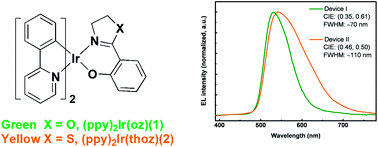New oxazoline- and thiazoline-containing heteroleptic iridium(iii) complexes for highly-efficient phosphorescent organic light-emitting devices (PhOLEDs): colour tuning by varying the electroluminescence bandwidth†
Abstract
Two new homologous phosphorescent iridium complexes, bis-(2-phenylpyridine)(2-(2′-hydroxyphenyl)-2-oxazoline)iridium(III) [(ppy)2Ir(oz)] (1) and bis-(2-phenylpyridine)(2-(2′-hydroxyphenyl)-2-thiazoline)iridium(III) [(ppy)2Ir(thoz)] (2), have been obtained in good yields and characterized by single-crystal X-ray diffraction, cyclic voltammetry, photoluminescence and electroluminescence studies, and by time-dependent density functional theory (TD-DFT) calculations. Using the two complexes, which differ only by the heteroatom (O or S) substitution at the same site in the ancillary ligand, as the emitter, doped in a 4,4′-bis(N-carbazolyl)biphenyl (CBP) host, gave phosphorescent organic light-emitting diodes (PhOLEDs) with very efficient green and yellow emission, respectively. The turn-on voltages for both devices are low (3.5–3.7 V). The green-emitting (ppy)2Ir(oz) – based device has a maximum brightness of 61 560 cd m−2 (at 16 V); maximum luminance efficiency of 66.2 cd A−1, 17.1% external quantum efficiency, 54 lm W−1 power efficiency and CIE coordinates of (0.35, 0.61) at a brightness of 10 000 cd m−2. For the yellow-emitting (ppy)2Ir(thoz)-based device with a wide full spectral width at half maximum (FWHM) of 110 nm, the corresponding values are 21 350 cd m−2 (at 14.5 V); 27.0 cd A−1, 8.5%, 18.0 lm W−1 and CIE coordinates of (0.46, 0.50). Colour tuning is primarily a consequence of the significantly wider emission bandwidth of complex 2 compared to complex 1.


 Please wait while we load your content...
Please wait while we load your content...